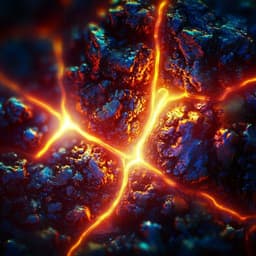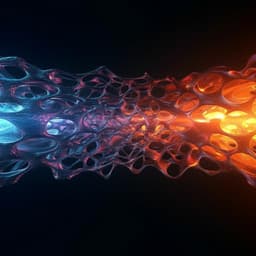
Physics
Electronic response of a Mott insulator at a current-induced insulator-to-metal transition
C. T. Suen, I. Marković, et al.
Unlock the mysteries of the Mott insulator Ca₂RuO₄ with groundbreaking research conducted by a team of experts. This study reveals how d.c. current induces a fascinating insulator-to-metal transition, shedding light on current-induced modifications to Ca₂RuO₄'s electronic states and their implications.
~3 min • Beginner • English
Introduction
Ca₂RuO₄ is a quasi-two-dimensional Mott system comprising layers of RuO₆ octahedra that undergo a temperature-driven insulator-to-metal transition (IMT) above T_IMT ≈ 357 K, with low-temperature insulating (S) and high-temperature metallic (L) phases distinguished by a shorter and longer c axis, respectively. At low temperatures, c-axis compression tilts and distorts RuO₆ octahedra, lifts the degeneracy of Ru t₂g states, and opens a Mott gap. The ground state is highly sensitive to external perturbations: the IMT can be tuned by chemical substitution, pressure, strain, electric fields, and by steady d.c. current, which stabilizes a nonequilibrium metallic state as long as current flows. While the zero-current IMT is linked to structural changes, the mechanism of the current-induced IMT remains unsettled. Under current, structural changes differ from thermal ones, yielding S* (insulating) and L* (metallic) phases with slightly larger and smaller c axes than their zero-current counterparts; current also suppresses antiferromagnetic order below T_N ≈ 110 K and can produce metal–insulator nanostripe patterns at intermediate current densities. To elucidate the electronic evolution across the current-driven IMT and disentangle intrinsic effects from field-induced artifacts, the study combines four-probe transport with spatially resolved ARPES (transport-ARPES), enabling direct momentum-resolved access to the electronic structure under current while tracking and correcting for stray field effects.
Literature Review
Prior work established the temperature-driven IMT in Ca₂RuO₄ and its strong magnetoelastic coupling, along with routes to tune the IMT via chemical substitution, pressure, and strain. Electric-field and current studies revealed a long-lived metallic state with negative differential resistance and identified distinct current-stabilized structures (S*, L*) and suppression of antiferromagnetism; nano-resolved microscopy uncovered nanostripe phase coexistence at intermediate current densities. Raman and X-ray spectroscopies probed nonequilibrium orbital and structural responses under current. The role of Joule heating has been debated, with studies emphasizing local temperature effects versus intrinsic field-driven mechanisms. Methodologically, in-operando ARPES approaches face challenges from stray electric and magnetic fields that shift and broaden spectra; recent theoretical work outlined how to access spectral functions in current-carrying devices. On the theory side, DMFT and Landau free-energy analyses have described the Mott transition and quantified lattice–electron coupling; recent studies highlighted orbital-dependent Mott physics and the importance of Hund’s coupling. However, comprehensive momentum-resolved measurements of the electronic structure under steady current, and a direct comparison to both DMFT using current-induced lattice parameters and to the high-temperature L phase, remained lacking.
Methodology
- Samples: High-quality Ca₂RuO₄ single crystals grown by optical floating zone; shaped to ~2×1×0.25 mm³. Characterized by Laue diffraction and SQUID magnetometry (T_N ≈ 110 K) to ensure phase purity.
- Transport-ARPES setup: Four-probe configuration with current applied along the crystallographic b axis using a Keithley 2400 SMU. Measurements performed at T = 180 K with continuous cooling to mitigate Joule heating. ARPES at 74 eV with σ- and π-polarized light; horizontal analyzer slit geometry. Experiments conducted at MAESTRO (ALS, LBNL) and equilibrium ARPES at QMSC (CLS). Samples cleaved in situ under UHV (~10⁻¹⁰ mbar).
- Mitigating stray fields: Magnetic field from current induces rigid momentum shifts; corrected by aligning high-symmetry points in k-space. Electric potential gradient across the sample shifts and broadens photoelectron energies. A micrometer-scale beamspot (15 μm diameter) is used to minimize energy broadening (≈75 meV). Spatial maps of Ca 3p core-level binding energy versus position along current flow identify homogeneous regions and quantify local potential gradients.
- Common energy referencing: Ca 3p core levels, largely insensitive to low-energy band changes, serve as binding-energy references. Measured core-level shifts are applied to valence spectra acquired at the same spot to recover intrinsic current-induced modifications near E_F. Extracted shifts: ~4.5 eV between S and S*, and ~1.6 eV between S and L*.
- ARPES measurements: Momentum-resolved spectra collected along orthorhombic high-symmetry cuts (XM, YM) with analyzer slit aligned along b or a axes to access different matrix elements. Fermi surfaces integrated within ±50 meV around E_F. Energy distribution curves (EDCs) and momentum distribution curves (MDCs) analyzed across the IMT.
- Theoretical calculations: Single-shot DFT+DMFT using neutron-diffraction-derived lattice structures for S, S*, L*, L. Wannier downfolding to Ru t₂g three-band model; includes non-cubic crystal fields and SOC. Interactions: Kanamori U = 1.9 eV, J = 0.4 eV. DMFT solved with CT-HYB QMC (TRIQS); self-energies analytically continued (maximum entropy) to obtain momentum- and orbital-resolved spectral functions and Fermi surfaces.
- Free-energy analysis: Landau theory with two order parameters: φ (orbital polarization controlling Mott state, φ=1 insulator, φ=0 metal) and η (field-directional orbital population imbalance). Free energy F(φ,η) expanded to fourth order with symmetry-allowed couplings; parameters adapted from literature. Phase diagram versus temperature and electric field constructed to rationalize distinct field- versus temperature-driven IMT pathways.
- Additional practical details: Grounding matched to analyzer; micro-mapping (15 μm spot) of cleaved area via Ca 3p peak intensity; contact geometry on back side; sample mounting with thermally conductive epoxies on sapphire substrate for thermal coupling and electrical isolation.
Key Findings
- Direct observation of current-induced electronic changes in Ca₂RuO₄ using transport-ARPES after correcting for stray fields via core-level referencing.
- Global reduction of the charge (Mott) gap upon entering the current-induced metallic L* phase from the insulating S phase, evidenced by increased spectral weight at E_F and redistribution of weight to lower binding energies across Ru and O valence bands.
- Quantified core-level energy shifts due to potential gradients: ~4.5 eV (S → S*) and ~1.6 eV (S → L*), enabling accurate energy alignment of valence spectra; current-induced energy broadening limited to ~75 meV with a 15 μm beamspot.
- Momentum-resolved changes in Ru t₂g bands along XM: in S (no current), flat bands near k* ≈ ±0.38 Å⁻¹ disperse downward towards X and remain below E_F; under current (L*), spectral weight at X near E_F increases while weight at k* decreases, consistent with a band crossing towards metallicity.
- Along YM (perpendicular Brillouin zone edge), Ru-band dispersion shows little to no modification across the IMT beyond spectral-weight redistribution, indicating pronounced anisotropy of the electronic response.
- The anisotropy correlates with structural changes under current: smaller change along a (Δa_S−L* ≈ 0.04 Å) versus larger along b (Δb_S−L* ≈ 0.2 Å), and the L* phase appears more isotropic than S in ARPES.
- ARPES Fermi surface in L* shows momentum-dependent spectral weight at E_F; DMFT using current-induced lattice constants reproduces the emergence of metallic FS features and the momentum-integrated spectral function trends.
- Comparative ARPES establishes that the current-induced L* Fermi surface differs from the high-temperature zero-current L phase (measured at T ≈ 384 K): L shows reduced anisotropy and distinct MDC lineshapes at the Brillouin zone edge, ruling out Joule heating as the sole cause of L*.
- I–V characteristics display negative differential resistance during the current-driven IMT, confirming high sample quality and complete transition when operated at sufficiently high current.
- Free-energy (Landau) analysis with coupled order parameters (φ, η) captures a field-driven first-order transition path distinct from the thermal route, explaining electronic distinctness of L* versus L and the role of directionality introduced by the electric field.
Discussion
The transport-ARPES measurements directly address how steady d.c. current drives Ca₂RuO₄ across the Mott IMT at the electronic-structure level. By controlling and correcting for stray electromagnetic fields via spatially resolved core-level referencing, the study reveals intrinsic modifications: a global gap reduction and a momentum-selective reorganization of Ru-band spectral weight, particularly along the XM direction, where the crystal experiences the largest current-induced lattice change. The absence of comparable dispersion changes along YM, together with the enhanced isotropy of the L* dispersion relative to S, links the electronic response to the reduction in orthorhombicity, highlighting tight coupling between lattice distortions and orbital-dependent electronic degrees of freedom. Comparison with DMFT using current-induced lattice parameters corroborates key features (emergent Fermi surface, redistribution of spectral weight), while discrepancies in the YM anisotropy suggest that additional correlations or matrix-element effects not fully captured by equilibrium DMFT may play a role. Crucially, the L* Fermi surface differs from that of the thermal L phase under identical photon energy and polarization, demonstrating that L* is not a trivial consequence of Joule heating but an electronically distinct steady state stabilized by current. The Landau free-energy framework with an additional field-directional order parameter rationalizes the distinct field-driven pathway and supports the interpretation of intertwined lattice and orbital physics governing the current-induced IMT.
Conclusion
This work establishes transport-ARPES as a powerful approach to probe the electronic structure of correlated materials under steady current. In Ca₂RuO₄, the current-induced IMT entails a global Mott-gap reduction and momentum-dependent reshaping of Ru-band dispersion, with pronounced anisotropy aligned with the direction of larger lattice response. The resulting L* metallic state is electronically distinct from the high-temperature L phase, excluding simple Joule heating scenarios. DMFT using current-induced lattice constants captures central aspects of the metallic state, and a Landau free-energy analysis accounting for field directionality provides a unifying qualitative description of the field- versus temperature-driven IMT pathways. These findings underscore the strong interplay of lattice and orbital-dependent electronic responses and open avenues to study current-induced phase transitions, competing orders, and emergent steady states in a wide range of strongly correlated systems. Future work could integrate time-resolved in-operando ARPES to access dynamics, extend DMFT to non-equilibrium regimes, and probe unoccupied states to complete the picture of band evolution.
Limitations
- Stray electric and magnetic fields from the applied current necessitate corrections; residual uncertainties remain (e.g., potential small chemical shifts ≲100 meV in core levels).
- Finite beamspot size introduces energy broadening (~75 meV); smaller spots improve resolution but reduce signal.
- Standard ARPES accesses only occupied states; inferred crossings in unoccupied regions rely on theory and spectral-weight trends.
- DMFT calculations capture many features but do not fully reproduce the observed anisotropy along YM, indicating missing ingredients (e.g., additional correlations or matrix-element effects).
- The free-energy description under current is effective, as true thermodynamic free energy is strictly defined in equilibrium.
- Sample-specific thresholds and geometries influence the critical current and homogeneity; intermediate-current domain patterns (nanostripes) were avoided here and not characterized in detail.
- One author affiliation (superscript 7) is not provided in the excerpt, limiting complete attribution.
Related Publications
Explore these studies to deepen your understanding of the subject.







